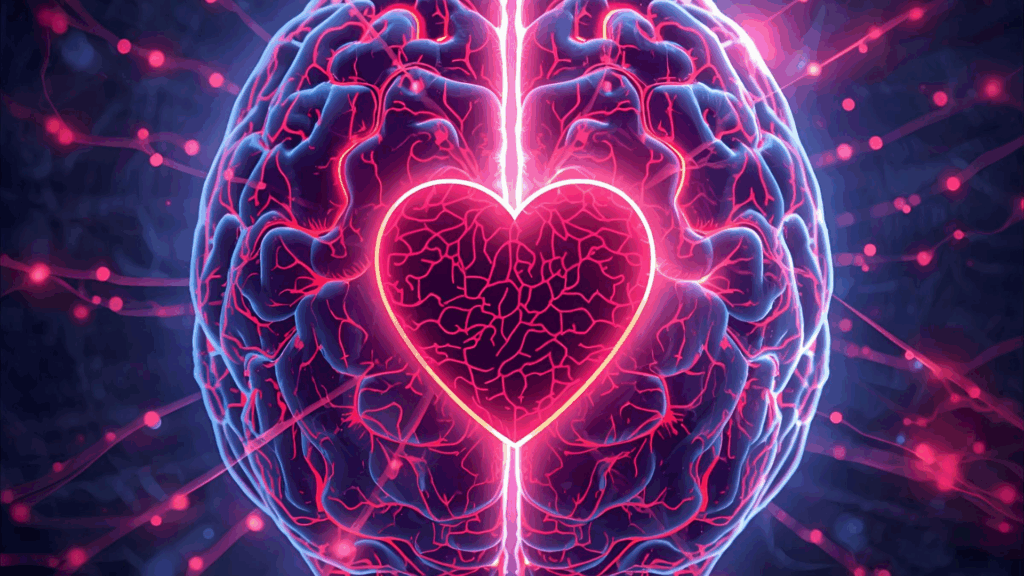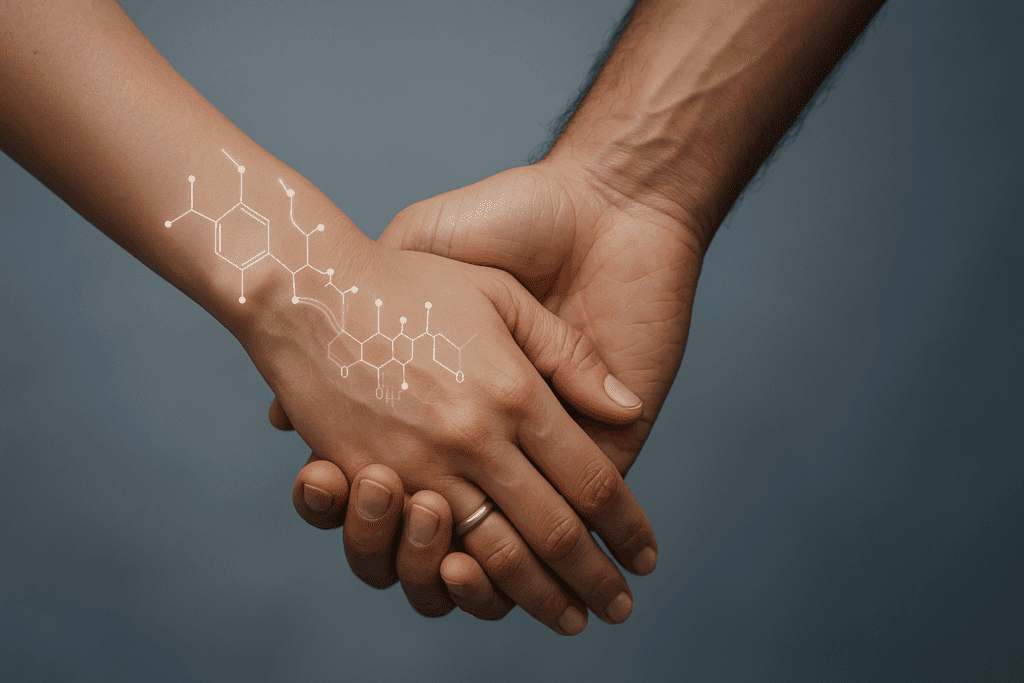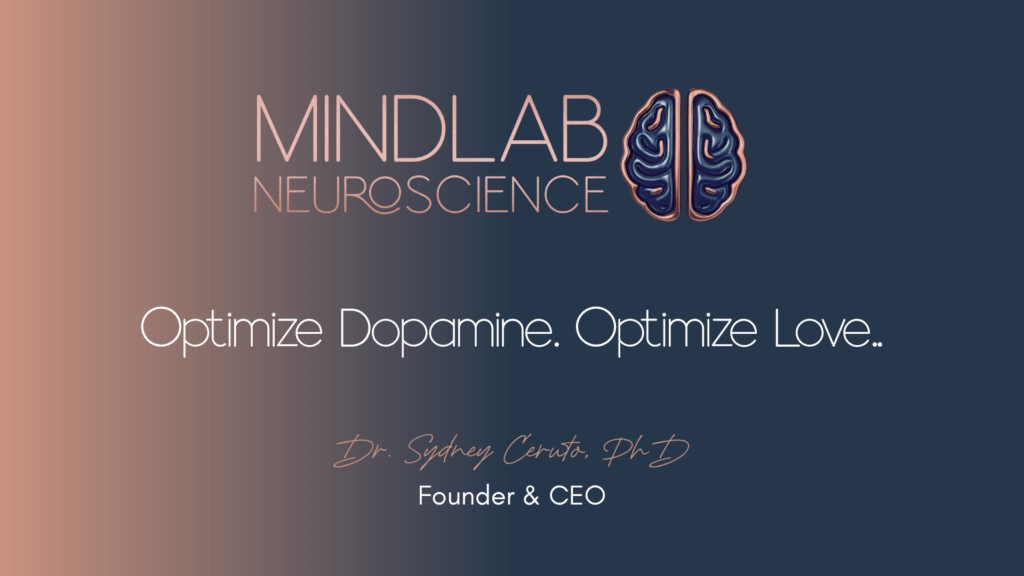Love feels like magic, but the truth is something even more powerful: it’s science. When you fall in love or feel deeply connected to the people who matter most, your brain is orchestrating an intricate dance of chemicals and electrical signals. Understanding how dopamine and relationships work together isn’t just fascinating—it transforms how you approach your most meaningful connections. This knowledge gives you real tools to strengthen bonds, navigate heartbreak, and create relationships that genuinely thrive.
How Your Brain Falls in Love: The Dopamine and Relationships Foundation
The moment someone captures your attention and your heart starts racing, dopamine is doing the heavy lifting. This powerful neurotransmitter floods your brain’s reward center, creating feelings of pleasure, excitement, and intense motivation. When dopamine and relationships principles are at work, you experience a craving to be near that person—similar to the way your brain responds to your favorite foods or accomplishments. It’s the biological fuel that powers attraction and keeps relationships moving forward.
Your brain doesn’t randomly choose who triggers this dopamine surge. Instead, it’s responding to signals of potential connection, compatibility, and even genetic fitness. Scientists studying people in love discovered that when they looked at photos of their romantic partners, specific brain regions lit up like fireworks. The ventral tegmental area (VTA), which is your brain’s dopamine factory, activated intensely. This wasn’t coincidence—it was your brain literally rewarding itself for recognizing someone special.
The nucleus accumbens, another critical brain region in dopamine and relationships science, also showed massive activation. This is the same region that activates when you eat delicious food or accomplish a goal you’ve been working toward. Your brain is telling you that this person matters. This isn’t superficial—it’s a profound biological validation that relationships are among the most important things your brain prioritizes.
What makes this process even more interesting is what happens in your prefrontal cortex during these moments of romantic activation. This region, responsible for critical thinking and judgment, shows decreased activity when you’re looking at someone you love. That’s why people say love makes you a little blind to flaws. Your brain actually suppresses your critical judgment center. You’re not being foolish—you’re experiencing a neurological shift that helps new bonds form by temporarily quieting the inner critic.

Understanding the Dopamine Rewards System in Relationships
The mesolimbic dopamine pathway is the highway that makes dopamine and relationships possible. This pathway connects your ventral tegmental area directly to your nucleus accumbens, creating what scientists call the reward system. Think of it as your brain’s motivational GPS, constantly sending signals about what’s worth pursuing and what matters most.
When you interact with someone you love—whether that’s a romantic partner, close friend, or family member—this dopamine pathway activates. Your brain releases dopamine into the nucleus accumbens, and you feel motivated, energized, and deeply satisfied. This isn’t manipulation by your brain. Rather, it’s an ancient survival mechanism that evolution refined over millions of years. Your ancestors who were motivated to build strong bonds had better survival rates, better protection from threats, and more support raising children to adulthood.
The dopamine and relationships system operates on a principle called reward prediction. Your brain learns to anticipate moments of connection. A text from your partner, the sound of their voice, or even seeing their favorite coffee order at a café can trigger dopamine release. Your brain has learned that these signals predict something valuable is coming. You’re not being clingy or desperate—you’re exhibiting completely normal dopamine-driven motivation.
One fascinating discovery in dopamine and relationships research comes from studying prairie voles, small rodents that form lifelong pair bonds. Scientists found that when male voles were separated from their partners, they experienced dopamine deficits in their reward centers. When reunited, dopamine surged dramatically. The voles showed the exact same activation patterns that humans show when reunited with loved ones. This cross-species consistency tells us something profound: the dopamine and relationships connection is ancient and deeply hardwired into our nervous systems.
The Evolution of Love: Why Your Brain Is Wired for Connection
Understanding dopamine and relationships makes complete sense when you consider the evolutionary pressures that shaped the human brain. For hundreds of thousands of years, humans survived not as isolated individuals but as members of tight-knit groups. The individuals who were naturally drawn to form strong bonds had enormous advantages.
Consider what your ancestors faced. A lone human is vulnerable to predators, unable to hunt large animals, and unable to protect offspring during the critical years of dependency. Humans have the longest childhood of any primate—it takes approximately two decades to reach full maturity. Parents needed partners to share the enormous workload of keeping children alive through all those vulnerable years. Groups with strong internal bonds hunted more successfully, defended territory more effectively, and shared parental responsibilities more efficiently.
This evolutionary pressure selected for brains that were exceptionally good at forming attachments. Over time, humans developed larger brains relative to body size specifically to manage complex social networks and relationships. Your brain literally grew to accommodate the cognitive demands of maintaining dozens of meaningful social connections. The dopamine and relationships science that makes you crave connection, feel comforted by presence, and experience pain at separation—these aren’t design flaws. They’re evidence that your brain is exactly the way it should be.
Natural selection favored people whose brains were highly motivated to seek proximity, invest in relationships, and experience deep satisfaction from connection. Your dopamine reward system is the biological embodiment of this evolutionary truth. When your brain releases dopamine in response to social bonding, it’s not a mistake—it’s the most fundamental human motivational system.

Beyond Dopamine: How Oxytocin Deepens Your Bonds Over Time
While dopamine creates the initial spark and motivation for connection, something else happens as relationships mature. A different neurochemical takes center stage, fundamentally changing how dopamine and relationships work together. This hormone is oxytocin, often called the bonding hormone or the love hormone.
Oxytocin is released during moments of physical closeness and intimacy. When you hug someone, hold their hand, or make love, oxytocin floods your system. Unlike dopamine, which creates excitement and motivation, oxytocin creates feelings of safety, trust, and calm. Your nervous system literally shifts into a state of security. Your stress hormone levels drop. Your heart rate and blood pressure normalize. You feel genuinely safe with that person.
The interplay between dopamine and relationships becomes richer when oxytocin enters the picture. Dopamine gets you interested and motivated to connect. Oxytocin keeps you there, deepening the bond and making long-term commitment possible. In early relationships, dopamine dominates. You feel excited and somewhat obsessed. You want to spend every moment together. Your brain is flooded with dopamine surges that make everything feel intense.
But if a relationship survives the initial intense phase—usually about six to nine months to two years—the chemistry shifts. Dopamine and relationships reach a new equilibrium. Dopamine levels return toward baseline, but oxytocin remains elevated. People often interpret this as “the love is fading,” but actually something richer is happening. You’re transitioning from passionate love to companionate love. This is when true partnership deepens, when you feel genuinely safe being vulnerable, when you can relax into sustained intimacy rather than constantly chasing the high.
Oxytocin also works in partnership with dopamine and relationships in ways that research is only beginning to understand. Recent studies found that oxytocin and dopamine receptors are often located on the same cells in the nucleus accumbens. Oxytocin can actually amplify dopamine signaling, making pair-bonded individuals more motivated toward their partners even as the initial fever of attraction cools. This is the neurochemistry of lasting love.
Vasopressin and Mate Guarding: The Third Piece of the Bonding Puzzle
Understanding dopamine and relationships becomes even richer when you add vasopressin to the equation. This hormone works alongside oxytocin and dopamine to create the full experience of committed partnership. Vasopressin is particularly important for what scientists call mate-guarding behaviors—the instincts that make you protective of your relationship and oriented toward preserving it.
Vasopressin levels increase when you’re in a pair-bonded relationship, and they’re particularly elevated in males across many species including humans. This hormone contributes to your sense of being bonded to one particular person and to behaviors that protect that bond. When your partner talks about an attractive colleague, vasopressin levels might spike. When you feel the sting of jealousy, vasopressin is part of the story.
Understanding dopamine and relationships helps explain one of the mysteries of modern commitment: why paired relationships feel different from early attraction. You’re not just addicted to the dopamine surge. You’re operating on a completely different neurochemical foundation. Vasopressin gives your bond a sense of protectiveness. You don’t just want to be near this person—you actively want to ensure that they remain in your life and that the relationship is protected from threats.
Like dopamine and relationships with oxytocin, vasopressin doesn’t work in isolation. The three neurochemicals interact in complex ways. Together, they create the full human experience of romantic love: the initial excitement and motivation (dopamine), the sense of safety and trust (oxytocin), and the protective commitment (vasopressin). Each serves a crucial function in understanding dopamine and relationships, and each is essential for relationships that actually last.

The Four Brain Regions Where Dopamine and Relationships Come Alive
When scientists put people in love into brain imaging machines, specific regions show consistent activation. Understanding these regions gives you insight into what’s happening when you fall in love, when you feel secure in a long-term relationship, and when heartbreak strikes. These brain regions form the foundation of how dopamine and relationships create the experience of being bonded.
The ventral tegmental area is essentially your brain’s dopamine production center. When you see your partner or anticipate spending time with them, neurons in your VTA fire more actively, releasing dopamine throughout your brain. This region doesn’t just respond to your partner—it evaluates all social and romantic information and decides what’s worth pursuing. The VTA is fundamentally about prioritization, and when you understand dopamine and relationships, you realize that your partner becomes one of your VTA’s top priorities.
The nucleus accumbens receives dopamine signals from the VTA and translates those signals into motivation and reward satisfaction. This region is active when you anticipate something pleasurable. For someone in a committed relationship, anticipating time with their partner activates the nucleus accumbens just as powerfully as anticipating a delicious meal or winning a competition. This explains why being in a healthy relationship can be so motivating—your brain is literally being rewarded by the thought of connection, demonstrating the tangible power of dopamine and relationships.
Your amygdala, the brain’s emotional processing center, shows interesting changes in people in love. When someone in a committed, secure relationship looks at their partner’s face, amygdala activity actually decreases. The amygdala is responsible for fear and threat detection. Lower amygdala activity around your partner means your nervous system has learned that this person is safe. You don’t need to maintain threat vigilance. You can relax. This is where dopamine and relationships connect to real psychological safety and emotional security.
The prefrontal cortex is your brain’s executive center, where judgment and critical thinking happen. During the early stages of love, this region shows decreased activity. You’re not thinking critically about your partner because your brain has temporarily de-prioritized criticism in favor of bonding. This isn’t irresponsible—it’s essential for forming close bonds. Understanding dopamine and relationships means recognizing that if your brain maintained full critical vigilance while developing new relationships, bonding would be nearly impossible. The prefrontal cortex activity patterns shift again in long-term relationships, where dopamine and relationships develop a more realistic, integrated view that includes both gifts and limitations.
How Attachment Styles Interact With Dopamine and Relationships
Your attachment style—the pattern of how you relate to others in close relationships—profoundly influences how dopamine and relationships manifest in your life. People with anxious attachment styles tend to have different dopamine response patterns than those with avoidant or secure styles. Understanding dopamine and relationships through the lens of attachment reveals why people respond so differently to connection.
If you have an anxious attachment style, your dopamine reward system might be extra sensitive to relationship signals. You feel powerful surges of dopamine when your partner shows attention and dramatic crashes when they seem distant. Your brain has learned to be vigilant about relationship security, so it’s hyperresponsive to signals of either connection or rejection. This isn’t weakness—it’s an adaptive pattern that likely developed in response to earlier relationships where attention was inconsistent or unreliable. Understanding dopamine and relationships from this perspective opens new possibilities for growth and healing.
Rather than judging yourself for being “too needy,” you can recognize that your dopamine system is calibrated toward detecting relationship safety or danger. With this awareness of dopamine and relationships, you can develop strategies to regulate your response: maintaining other meaningful relationships, building practices that create dopamine without depending on a single person, and creating secure rituals with partners that prove consistent connection.
People with avoidant attachment styles often have different dopamine patterns. Their dopamine reward system might be less responsive to social connection because earlier experiences taught them that closeness wasn’t safe or reliable. Rather than seeking dopamine surges through connection, avoidantly attached people might seek dopamine through independence, achievement, or novelty. This creates a fundamental challenge when understanding dopamine and relationships: if connection doesn’t reliably trigger your reward system, maintaining close relationships becomes cognitively difficult.
Secure attachment, the goal we’re all moving toward, involves dopamine and relationships that’s balanced and flexible. Your brain releases appropriate dopamine in response to connection without becoming dysregulated by normal relationship fluctuations. You can feel the oxytocin safety of your partner while also maintaining the prefrontal cortex perspective needed for healthy independence. Your dopamine and relationships system motivates connection without desperation, and your amygdala relaxation allows genuine intimacy.
The Neurobiology of Heartbreak: Why Losing Connection Hurts So Profoundly
If understanding dopamine and relationships explains why love feels so good, it also explains why heartbreak hurts so intensely. When a significant relationship ends, your brain doesn’t just feel sad—it experiences genuine pain signals similar to physical injury.
Brain imaging studies of people going through breakups show that the anterior cingulate cortex, the same region that processes physical pain, activates during emotional pain. Additionally, the nucleus accumbens, which has been flooded with dopamine during the relationship, suddenly experiences a dramatic dopamine deficit. You’ve lost your primary dopamine source. Your brain doesn’t just feel emotionally devastated—it’s experiencing literal neurochemical withdrawal. Understanding dopamine and relationships includes understanding this painful reality.
Your stress response systems also activate. Cortisol and other stress hormones spike as your body interprets the loss as a threat. This is why heartbreak can cause physical symptoms: difficulty sleeping, appetite changes, chest pain, and overall malaise. Your dopamine and relationships foundation has been disrupted, and your entire nervous system is responding to what feels like a genuine survival threat.
However, understanding dopamine and relationships in the context of heartbreak also points toward healing. Heartbreak isn’t a sign of weakness—it’s evidence of a brain that has successfully bonded. Your dopamine and relationships system worked exactly as it should have: it created a powerful motivation to maintain this connection. The pain you feel is the other side of the connection you experienced. And crucially, your brain is neuroplastic. Over time, new neural pathways form. The nucleus accumbens gradually resets. Dopamine sources expand beyond the lost relationship. You literally grow new neural networks.

Building Stronger Bonds: Practical Applications of Dopamine and Relationships
Understanding dopamine and relationships isn’t just intellectually interesting—it offers concrete guidance for strengthening your most important connections. These principles work across all your significant relationships: romantic partnerships, close friendships, family relationships, and even mentoring relationships. Applying what you know about dopamine and relationships can transform how you approach every meaningful bond in your life.
Consistent, predictable connection creates the healthiest dopamine and relationships dynamics. Your dopamine reward system thrives on reliable patterns. Rather than occasionally grand gestures, regular connection—daily check-ins with your partner, weekly time with close friends, consistent family rituals—trains your brain to maintain elevated oxytocin and dopamine. These regular interactions keep your dopamine and relationships system engaged and your bonding neurochemicals balanced.
Physical touch is surprisingly powerful in dopamine and relationships dynamics. Oxytocin and dopamine both respond to physical proximity and touch. This doesn’t mean that relationships require sexual intimacy—though that’s one powerful way to activate these systems. Regular hugs, hand-holding, or even just sitting close together releases oxytocin and reinforces dopamine pathways. Partners who maintain physical affection report higher relationship satisfaction, and now you understand why: they’re literally maintaining their dopamine and relationships neurochemistry of connection.
Novelty and shared experiences keep dopamine and relationships alive in long-term relationships. Once you’ve been with someone for years, routine can dampen dopamine responses. But new experiences together—traveling to new places, trying new activities, learning something together—trigger dopamine surges similar to early attraction. This explains why understanding dopamine and relationships reveals that couples who make time for novel, shared experiences report that their relationships feel fresher and more connected.
Vulnerability and authentic self-disclosure activate dopamine and relationships in profound ways. When you allow someone to see your real self—not your polished, performance version—and they respond with acceptance, your brain gets a powerful signal that you can be safe being authentic. Understanding dopamine and relationships shows that oxytocin surges in response to genuine intimacy. Your prefrontal cortex relaxes its vigilance. Your amygdala confirms this person is genuinely safe.
Protecting Your Bond: How Dopamine and Relationships Can Be Disrupted
Just as understanding dopamine and relationships helps you build stronger connections, it also reveals how bonds can be damaged. Chronic stress, for instance, elevates cortisol and actually suppresses dopamine production. Couples under high stress often experience their dopamine and relationships foundation breaking down, not because they love each other less, but because their stressed nervous systems can’t maintain the necessary neurochemistry.
Betrayal and broken trust create lasting changes in dopamine and relationships patterns. When someone you trusted violates that trust, your amygdala resets its threat assessment of this person. Your dopamine reward system stops responding to their presence with pleasure—instead, it responds with caution. Rebuilding dopamine and relationships trust after betrayal requires literally rebuilding neural pathways. This is why trust violations, even relatively small ones, can take months to overcome.
Chronic criticism and contempt in relationships also disrupt dopamine and relationships dynamics. When interactions become primarily negative, your brain stops associating this person with reward. Dopamine stops flowing toward them. Oxytocin decreases. Your amygdala remains activated because your nervous system interprets this person as a source of threat rather than safety. Many relationships decline not because of a sudden disaster but because small negative patterns accumulate until your dopamine and relationships system can’t sustain the bond.
Paradoxically, excessive technology use and constant distraction can also damage dopamine and relationships. Your dopamine reward system responds to novelty and stimulation. Constantly checking your phone provides novel dopamine hits. Partners present in person become less novel and therefore less dopamine-rewarding than the constant stimulation of social media or messaging. Couples who protect phone-free time together preserve their dopamine and relationships neurochemistry.

Creating Your Resilience: How Connection Strengthens Your Brain
Beyond romance, understanding dopamine and relationships reveals how strong connections literally make you more resilient. Social connection isn’t a luxury—it’s fundamental to your nervous system’s ability to handle stress. The science of dopamine and relationships shows why your bonds matter for your health.
People with secure, satisfying relationships show different dopamine responses to stress than isolated individuals. Their reward system remains more engaged even during challenging periods. They literally have more dopamine available to cope with difficulty. Additionally, oxytocin from secure relationships dampens the stress response. Understanding dopamine and relationships from a resilience perspective shows that cortisol levels remain lower when you have secure bonds. The vagus nerve, which carries signals between your brain and body, maintains better tone when you’re in secure relationships.
Research on social resilience consistently shows that people with strong relationships recover faster from illness, manage chronic stress better, and maintain cognitive function longer as they age. The dopamine and relationships science of these benefits is becoming clear: secure attachments literally buffer your nervous system against the wear and tear of stress.
Loneliness, by contrast, creates a cascade of neurochemical problems. Chronic loneliness depresses dopamine production, making pleasure feel muted and motivation harder to generate. Cortisol stays elevated, triggering inflammation throughout your body. Your amygdala remains hypervigilant because your nervous system interprets isolation as a survival threat. Understanding dopamine and relationships means recognizing that this is why social isolation is so profoundly unhealthy—it disrupts the entire neurochemical system that evolution built to keep us healthy.
Integration: Understanding Your Own Neurochemistry
The most powerful application of understanding dopamine and relationships isn’t academic—it’s personal. Recognizing how dopamine and relationships work in your own life transforms your ability to navigate them consciously.
When you feel desperately anxious about a partner’s attention, you can recognize this as dopamine sensitivity rather than a character flaw. When you feel resistant to deep connection, you can understand this as an attachment pattern shaped by your nervous system, not a permanent trait. When a relationship ends and the pain feels unbearable, you can know that your brain is literally in withdrawal and that time and new connections will gradually restore your dopamine balance.
This knowledge also helps you approach relationships more consciously. Rather than just following impulses, you can make deliberate choices about how to maintain dopamine and relationships that supports genuine connection. You can recognize when patterns aren’t serving you and make changes. Understanding dopamine and relationships gives you the ability to build relationships on a foundation of knowledge rather than just chemistry.
Finally, the science of dopamine and relationships teaches us something profound about human nature. We aren’t designed to thrive alone. Our brains are literally shaped by millions of years of evolution to reward connection, to find meaning in relationships, and to experience our greatest satisfaction through genuine bonding. The dopamine and relationships connection that makes us crave connection isn’t a weakness—it’s evidence of our deepest humanity.

Question 1: “I’ve been hurt before and I’m afraid of getting close to someone again. How can I overcome this fear and actually be open to love?”
Through consistent, trustworthy experiences with safe people, your brain gradually resets its threat assessment. This is where understanding dopamine and relationships becomes powerful. When you work with someone trained in how dopamine and relationships actually function, you learn to slowly rebuild your capacity for trust. It’s not about forcing yourself to be vulnerable before you’re ready. It’s about creating a safe container where your nervous system can gradually learn that connection doesn’t have to mean pain.
Many of my clients discover that their “walls” weren’t weakness—they were their brain’s intelligent protection mechanism. Once we understand that and work with your nervous system rather than against it, opening to love becomes possible again. It takes time, patience, and support, but your brain is far more resilient than you think.
Question 2: “How does understanding dopamine and relationships help me attract someone who’s actually right for me, not just someone with chemistry?”
When you understand dopamine and relationships, you develop what I call “conscious attraction.” You can feel the dopamine spark while also engaging your prefrontal cortex—your thinking brain—to assess actual compatibility. You ask better questions. You notice red flags. You look for signs of secure attachment rather than just chemistry. Most importantly, you understand that the initial dopamine surge naturally decreases over time.
Rather than thinking “the spark died,” you can consciously build oxytocin—the attachment hormone—through consistent, vulnerable connection. This means you’re actually selecting for long-term partnership rather than short-term intensity. People who understand dopamine and relationships tend to make better choices about who they invite into their lives because they’re not just chasing a neurochemical high.
Question 3: “I struggle with anxiety in relationships. Does understanding dopamine and relationships actually help with that, or is it just information?”
But once you understand this, you can work with it intentionally. Through coaching, you learn to regulate your dopamine response: building other sources of dopamine outside the relationship, creating secure rituals with your partner that prove reliable connection, and understanding your attachment triggers so you can respond consciously rather than reactively. Over time, your nervous system literally recalibrates. Your amygdala stops treating your partner as a potential threat. Your dopamine responses become more stable.
Your anxiety doesn’t disappear overnight, but it transforms from something that controls you into something you can understand and manage. That’s the real power of dopamine and relationships coaching—it gives you tools that work with your brain rather than against it.
Question 4: “How do I know if I’m ready for a serious relationship? How do I stop sabotaging connection when things get real?”
These aren’t moral questions—they’re neurobiological ones. If you find yourself sabotaging connection when things get real, it’s usually because your nervous system interprets intimacy as danger. Your amygdala activates. You create distance or conflict as a way to regain control. Once you understand this pattern through the lens of dopamine and relationships, you can interrupt it. You learn to recognize the moment your nervous system is hijacking the relationship. You develop tools to regulate yourself so you can stay present.
Real readiness for serious relationship comes when you can maintain your sense of self while being genuinely close to another person. That’s what we work toward together, and it’s absolutely achievable.
Question 5: “After a breakup, how long does it actually take to heal? Will I ever feel normal again?”
The timeline for healing varies because it depends on several factors: how long you were together, whether there was betrayal, and crucially, whether you understand dopamine and relationships enough to rebuild your dopamine system intentionally. Some people languish in heartbreak for years because they’re waiting for time to heal them. Others actively rebuild through new connections, meaningful pursuits, physical activity, and community. Understanding dopamine and relationships means you can accelerate your recovery.
You can deliberately create dopamine through activities you enjoy, rebuild oxytocin through safe friendships and family, and support your nervous system through this transition. Will you feel normal again? Yes—but often you feel better than normal. You’ve learned something profound about yourself. Your brain has neuroplasticity on its side. And typically, within six to twelve months of intentional work, people report feeling genuinely healed and actually more open to love than before, because they understand themselves so much better.
For more insight, read: How to Optimize Neuroplasticity In Relationships
#dopamineandrelationships #neuroscience #love #relationships #dopamine #attachment #bonding #oxytocin #vasopressin #brainchemistry #romanticlove #socialbonds #pairbonding #attachmentstyles #emotionalhealth #mentalhealth #psychology #personalgrowtth #relationshipscience #intimacy



